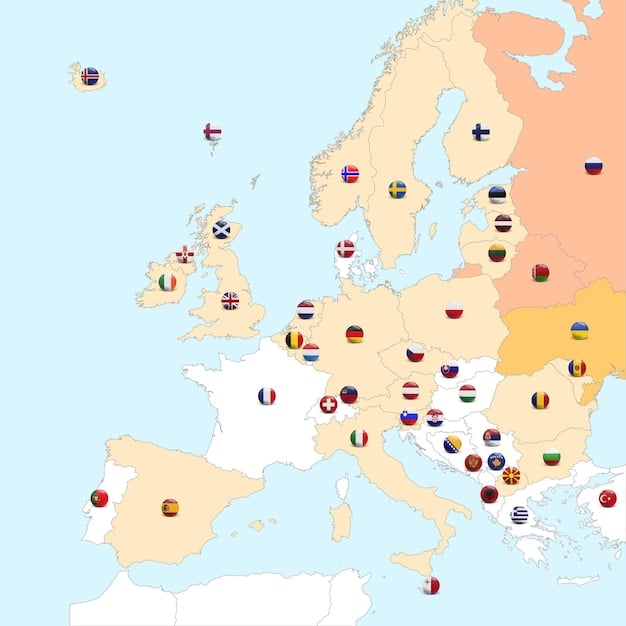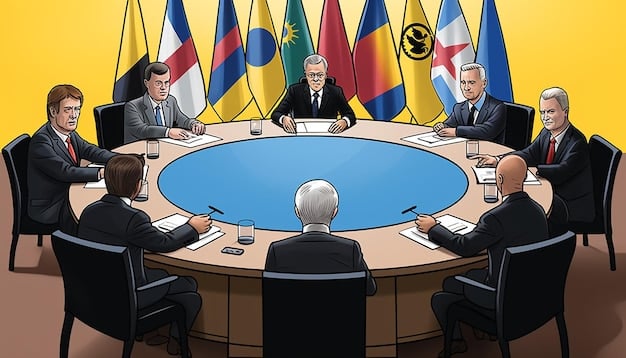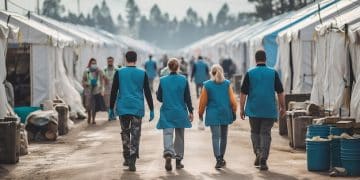US Response to Europe’s Refugee Crisis: A Comprehensive Look

Advertisements
The United States is expected to respond to Europe’s escalating refugee crisis through a multifaceted approach, blending humanitarian aid, diplomatic engagement, and strategic partnerships, while navigating complex domestic and international pressures to formulate effective, long-term solutions.
As Europe grapples with an increasingly complex and burgeoning refugee crisis, a critical question arises: How Will the US Respond to the Growing Refugee Crisis in Europe? This multifaceted issue demands a comprehensive understanding of geopolitical dynamics, humanitarian imperatives, and the intricate balance of international relations. Our exploration delves into the potential avenues, challenges, and strategic considerations that will shape the American stance.
Understanding the Scope of Europe’s Refugee Crisis
Europe’s refugee crisis is not a singular event but a continuous, evolving challenge driven by a confluence of factors including conflict, persecution, political instability, and economic hardship in various parts of the world. The sheer scale and complexity of forced displacement present significant humanitarian, social, and economic strains on receiving nations.
Recent years have seen a surge in arrivals from regions like Ukraine, Syria, Afghanistan, and various sub-Saharan African countries, each wave presenting unique integration challenges and humanitarian needs. The crisis underscores the interconnectedness of global affairs, where events in distant lands can have immediate and profound impacts on European society and, by extension, global partners.
Drivers of Displacement
The primary drivers behind the large-scale displacement of populations towards Europe are diverse and often overlapping. Understanding these root causes is crucial for formulating effective, long-term responses that go beyond immediate humanitarian relief.
- Wars and protracted conflicts in countries such as Ukraine, Syria, and Sudan continue to force millions from their homes, seeking safety and stability abroad.
- Political instability and governance failures, particularly in parts of Africa and the Middle East, erode trust in state institutions and often lead to widespread human rights abuses.
- Poverty, economic marginalization, and climate change impacts exacerbate existing vulnerabilities, compelling individuals and families to seek opportunities and a better life elsewhere.
- Persecution based on ethnicity, religion, political opinion, or sexual orientation remains a driving factor for many seeking asylum and international protection.
Impact on European Nations
The influx of refugees and asylum seekers places substantial pressure on European infrastructure, public services, and social cohesion. While many nations have demonstrated remarkable solidarity, the sheer volume can strain resources and ignite political debates.
From housing and healthcare to education and employment, European countries face the monumental task of absorbing and integrating new populations, often with differing cultural backgrounds and traumatic experiences. This necessitates significant financial investment and comprehensive policy frameworks to ensure successful integration and prevent social divisions.
The long-term implications of these demographic shifts are profound, influencing labor markets, social welfare systems, and even foreign policy decisions as Europe seeks to stabilize its immediate neighborhood and address the root causes of forced migration. The crisis also tests the unity and resilience of the European Union, as member states grapple with equitable burden-sharing and common asylum policies.
Historical Precedents: US Engagement in Refugee Crises
The United States has a long and complex history of engaging with international refugee crises, reflecting a blend of humanitarian values, strategic interests, and domestic political considerations. Understanding past responses provides valuable context for predicting how the U.S. might act in the current European situation.
From the aftermath of World War II, which saw the establishment of international refugee frameworks, to the Cold War era’s embrace of political asylum for those fleeing communist regimes, the U.S. has often played a leading role. Notable historical instances include the resettlement of Vietnamese “boat people” in the late 1970s and early 80s, Bosnians in the 90s, and various African and Middle Eastern populations in subsequent decades.
Post-War Resettlement Programs
Following World War II, the U.S. implemented extensive resettlement programs, notably the Displaced Persons Act of 1948 and the Refugee Relief Act of 1953. These legislative actions facilitated the entry of hundreds of thousands of European refugees, demonstrating a commitment to humanitarian aid on an unprecedented scale.
These programs laid the groundwork for future U.S. refugee policy, establishing the principle that the nation bears a responsibility to assist those displaced by conflict and persecution. They also highlighted the logistical challenges and triumphs of large-scale resettlement, offering lessons in inter-agency coordination and public-private partnerships.
Cold War Era and Beyond
During the Cold War, U.S. refugee policy often intertwined with its broader geopolitical strategy, offering refuge to those fleeing communist regimes. This period saw significant intakes from Hungary (1956), Cuba (from 1959), and later Southeast Asia following the Vietnam War.
More recent responses have seen the U.S. engaging in diverse ways, from funding international humanitarian organizations to direct resettlement efforts and diplomatic initiatives aimed at addressing root causes. The 2010s saw significant U.S. involvement in the Syrian refugee crisis, though domestic political shifts at times impacted the scale of resettlement efforts.
The experiences from these varied historical responses underscore the dynamic nature of U.S. involvement. They reveal a pattern where humanitarian concern is often tempered by practical limitations, domestic political will, and the overarching objectives of U.S. foreign policy. The lessons learned from past successes and failures will undoubtedly inform the current administration’s approach to Europe’s ongoing crisis.
Potential Avenues for US Response
The United States’ response to the growing refugee crisis in Europe is likely to be multifaceted, involving a combination of financial aid, diplomatic engagement, and potential resettlement efforts. The complexity of the crisis necessitates a nuanced approach that addresses both immediate humanitarian needs and long-term stability.
No single solution will suffice, and the U.S. approach will probably involve coordination with European allies, international organizations, and non-governmental actors. The strategy will aim to alleviate pressure on frontline European states while adhering to American humanitarian principles.

Financial and Humanitarian Aid
A primary component of the U.S. response will almost certainly be continued and potentially increased financial assistance. This aid typically flows through established international channels and is directed towards various crucial areas:
- Emergency Relief: Funds for food, shelter, medical supplies, and other immediate necessities for refugees and asylum seekers.
- Support for Host Nations: Financial contributions to European countries disproportionately affected by refugee arrivals, helping them manage the burden on public services.
- Capacity Building: Investments in programs designed to strengthen refugee processing, integration services, and legal aid in European nations.
- Support for Source Countries: Direct aid to countries experiencing conflict or instability, aimed at addressing root causes of displacement and improving internal conditions.
This financial support is critical for alleviating the immediate suffering and enabling European nations to cope with the influx. It also demonstrates U.S. solidarity and commitment to shared humanitarian values.
Diplomatic Engagement and Policy Coordination
Beyond financial aid, the U.S. will likely engage in robust diplomatic efforts aimed at fostering collaborative solutions. This includes:
- Bilateral and Multilateral Dialogues: Working closely with individual European Union member states and the EU as a whole to coordinate policies and share best practices.
- Global Refugee Summits: Participating in and potentially leading international forums to address the crisis comprehensively, seeking global burden-sharing agreements.
- Addressing Root Causes: Engaging in diplomatic initiatives to resolve conflicts, promote good governance, and address climate change in countries of origin, thereby reducing future displacement.
Effective diplomacy is crucial for a coordinated international response, preventing unilateral actions that could exacerbate the crisis, and fostering a shared vision for managing migration flows.
Resettlement and Asylum Policy Adjustments
While the focus is often on humanitarian aid to Europe, the U.S. may also consider adjustments to its own resettlement and asylum policies. Changes could include:
- Increased Refugee Admissions: Expanding the annual refugee ceiling to allow for greater U.S. intake, particularly for vulnerable populations identified in cooperation with European partners.
- Streamlined Asylum Processes: Reviewing and potentially streamlining asylum procedures to ensure efficient and humane processing of claims, both domestically and, in some cases, abroad.
- Family Reunification Programs: Prioritizing processes that allow refugees to reunite with family members already in the U.S., offering a path to stability and integration.
Any changes to U.S. resettlement policy will be subject to domestic political considerations and the capacity of U.S. agencies to manage increased caseloads. However, such adjustments would demonstrate a direct commitment to responsibility-sharing on a global scale.
Challenges and Constraints for US Engagement
While the United States is expected to respond to Europe’s refugee crisis, several significant challenges and constraints will shape the nature and extent of its involvement. These factors can limit both the willingness and capacity of the U.S. to act, demanding careful navigation of domestic and international realities.
The decision-making process will balance humanitarian imperatives with geopolitical interests, economic capacities, and the ever-present considerations of public opinion. Overcoming these hurdles will require pragmatic policy-making and strategic diplomacy.
Domestic Political Climate
One of the most significant constraints on U.S. refugee policy is the prevailing domestic political climate. Public opinion on immigration and refugee resettlement varies widely, and policy decisions are often highly politicized.
Economic downturns, national security concerns, or perceived strains on social services can trigger calls for more restrictive policies. Conversely, strong advocacy from humanitarian organizations and international allies can push for greater engagement. The balance of power in Congress and the priorities of the executive branch will heavily influence the direction of U.S. policy.
Furthermore, the narrative around refugees – whether they are viewed primarily as a humanitarian obligation or a potential threat – plays a crucial role in shaping public and political appetite for U.S. action. This internal debate often makes it challenging to forge a consistent and expansive refugee response.
Economic Considerations
Responding to a large-scale international crisis, particularly one involving humanitarian aid and potential resettlement, comes with substantial economic costs. The allocation of federal funds for refugee programs can be a contentious issue, especially during periods of fiscal austerity or competing domestic priorities.
Funding for international aid, processing centers, integration services, and the administrative costs associated with increased refugee intake can run into billions of dollars. Convincing lawmakers and the public to commit significant resources to an overseas crisis, even one with humanitarian urgency, can be a tough sell amidst competing demands within the U.S. budget.
Global Geopolitical Landscape
The U.S. must also consider the broader global geopolitical landscape when formulating its response. Its actions in Europe could have ripple effects in other regions, influencing relationships with key allies and rivals.
For example, diverting resources to Europe might be seen as neglecting other pressing humanitarian crises elsewhere. Balancing its commitments and interests in the Middle East, Africa, and Asia while addressing the European situation requires delicate strategic planning.
Additionally, the U.S. may seek to avoid inadvertently encouraging further irregular migration or creating pull factors that could destabilize other regions. The complex interplay of international law, national sovereignty, and multilateral cooperation will continuously shape the boundaries of U.S. engagement in Europe’s refugee crisis.
Strategic Partnerships and International Cooperation
In addressing Europe’s escalating refugee crisis, the United States will undoubtedly leverage and seek to strengthen its strategic partnerships and promote international cooperation. This collaborative approach recognizes that no single nation can solve the complex challenges of forced displacement alone.
Working in concert with allies and international bodies allows for a more efficient allocation of resources, greater diplomatic leverage, and the development of comprehensive, sustainable solutions. The U.S.’s role will likely involve both direct engagement and supporting existing multilateral frameworks.
Collaboration with European Union and Member States
A cornerstone of the U.S. response will be enhanced collaboration with the European Union and its individual member states. Given Europe’s direct exposure to the crisis, their experience and policy frameworks are invaluable.
- Policy Dialogue: Establishing regular high-level dialogues to share intelligence, discuss best practices for border management, asylum processing, and integration.
- Joint Initiatives: Potentially launching joint programs focused on specific aspects of the crisis, such as combating human trafficking networks or supporting refugee education.
- Burden Sharing: Working to encourage more equitable burden sharing among EU members and exploring how the U.S. can contribute to reducing the strain on frontline states.
Such collaboration aims to foster a unified approach, avoiding disjointed or conflicting policies that could undermine efforts to manage the crisis effectively.
Engagement with United Nations Agencies
The U.S. is a significant donor to and partner with various United Nations agencies, including the UNHCR (UN Refugee Agency) and IOM (International Organization for Migration). These agencies play a critical role in providing humanitarian assistance and coordinating international responses.
- Funding: Continuing to provide substantial financial contributions to UNHCR and IOM to support their global operations, including those in Europe and regions of origin.
- Logistical Support: Offering logistical expertise and resources to assist with the delivery of aid, establishment of processing centers, and safe transportation of refugees.
- Advocacy: Using its diplomatic influence within the UN system to advocate for stronger international norms for refugee protection and more robust global mechanisms for burden-sharing.
These partnerships are vital for ensuring that humanitarian aid reaches those most in need and that international law and human rights principles are upheld in the response to the crisis.
Working with Non-Governmental Organizations (NGOs)
NGOs, both international and local, are often on the front lines of humanitarian response. The U.S. frequently partners with and funds these organizations to deliver aid and implement programs.
This includes supporting organizations involved in emergency relief, psychological support, legal aid, and long-term integration services for refugees in Europe. NGOs often have unparalleled access to affected populations and a deep understanding of local needs, making them indispensable partners in crisis response.
By investing in these strategic partnerships, the U.S. can amplify the impact of its response, ensuring that its contributions are effectively channeled and that the overall international effort is cohesive and robust. The success of the U.S. response will largely depend on its ability to foster and maintain these critical cooperative relationships.
Long-Term Implications and Future Outlook
The way the United States responds to Europe’s current refugee crisis will have significant long-term implications, not only for the humanitarian situation itself but also for transatlantic relations, global migration governance, and U.S. foreign policy. The approach taken now could set precedents for future responses to similar crises.
Sustainable solutions often move beyond immediate aid, focusing on addressing root causes, promoting stability in conflict zones, and fostering effective integration strategies. The U.S.’s role will be crucial in shaping this long-term outlook, reflecting its capacity for global leadership and its commitment to international stability.

Impact on Transatlantic Relations
A strong and coordinated U.S. response can significantly bolster transatlantic ties. Shared responsibility in addressing the refugee crisis can reaffirm the alliance between the U.S. and Europe, deepening trust and cooperation on a range of global issues.
Conversely, a perceived lack of engagement or a unilateral approach could strain these relationships. European nations, facing the immediate pressure of large-scale arrivals, will be looking for concrete support and solidarity from their American ally. The effectiveness of the U.S. response will, therefore, serve as a test of the strength and relevance of the transatlantic partnership.
Shaping Global Migration Governance
The U.S. response has the potential to influence the evolving landscape of global migration governance. By engaging constructively, the U.S. can help shape international norms, conventions, and practices related to refugee protection and managed migration.
Through its participation in multilateral forums and its bilateral engagements, the U.S. can advocate for principles of burden-sharing, humane treatment of asylum seekers, and durable solutions such as voluntary repatriation, local integration, or resettlement. Its actions will contribute to the collective effort to create a more orderly and dignified process for displaced populations worldwide.
Future of US Foreign Policy in Humanitarian Contexts
How the U.S. responds to the European refugee crisis will also offer insights into the future direction of U.S. foreign policy in humanitarian contexts. It will indicate the extent to which humanitarian concerns remain a central pillar of its global engagement, alongside strategic and economic interests.
A robust and empathetic response could signal a renewed commitment to human rights and international humanitarian law as cornerstones of American foreign policy. It could also influence future resource allocation for international aid and the prioritization of diplomatic efforts aimed at conflict resolution and long-term stability in vulnerable regions.
Ultimately, the U.S. approach to Europe’s refugee crisis is not just about immediate aid; it’s about defining its role on the global stage, reinforcing key alliances, and contributing to the development of a more resilient and humane international system for managing forced displacement in the years to come.
Ethical Considerations and Moral Imperatives
Beyond geopolitical strategy and economic considerations, the U.S. response to Europe’s refugee crisis is deeply intertwined with ethical considerations and moral imperatives. The treatment of displaced persons raises fundamental questions about human dignity, international responsibility, and the values that underpin a humane society.
These ethical dimensions call for a response that not only addresses immediate practical needs but also upholds principles of compassion, justice, and non-discrimination. The U.S. has often projected itself as a beacon of human rights, and its actions in this crisis will be scrutinized against this self-perception.
Responsibility to Protect (R2P) and Humanitarian Aid
The concept of “Responsibility to Protect” (R2P), though primarily focused on state responsibility to prevent mass atrocity crimes against their own populations, extends to the international community’s role when states fail. While not directly applicable to all refugee situations, the underlying principle of states protecting vulnerable populations resonates deeply within humanitarian response frameworks.
The U.S.’s history of providing significant humanitarian aid is rooted in a moral imperative to alleviate suffering. This commitment is not merely an act of charity but a recognition of shared humanity and the interconnectedness of global well-being. Providing aid to Europe’s refugee crisis is an extension of this fundamental ethical obligation.
Upholding International Law and Human Rights
The U.S. is a signatory to various international conventions that establish the rights of refugees and asylum seekers, most notably the 1951 Refugee Convention and its 1967 Protocol. Adhering to these legal frameworks is a moral obligation that dictates principles of non-refoulement (not returning refugees to places where their lives or freedom would be threatened) and fair asylum procedures.
Any U.S. policy will need to align with these international standards, ensuring that responses are not only effective but also just and respectful of human rights. This includes ensuring access to legal counsel, humane conditions, and due process for all asylum seekers, regardless of their origin or circumstances.
Long-Term Moral Responsibility
The ethical dimension of the crisis also extends to long-term moral responsibilities. This includes not only assisting with immediate needs but also contributing to durable solutions that facilitate integration and self-sufficiency for those who cannot safely return home.
Investing in education, job training, and social support for refugees, whether in Europe or those resettled in the U.S., reflects a commitment beyond mere temporary relief. It acknowledges the inherent dignity and potential of individuals forced from their homes and provides them with the means to rebuild their lives. The moral imperative, therefore, calls for a comprehensive, sustainable, and compassionate response that looks beyond the immediate crisis toward a future of stability and dignity for all.
| Key Point | Brief Description |
|---|---|
| 🌍 Diverse Drivers | Conflicts, political instability, and economic hardship are primary causes of mass displacement to Europe. |
| 💵 US Financial Aid | The U.S. will likely provide significant financial and humanitarian aid through international channels and directly to affected nations. |
| 🤝 Diplomatic Engagement | Intensive diplomatic efforts and coordination with the EU are crucial for a unified and effective response. |
| ⚖️ Ethical Imperatives | The response must uphold human rights, international law, and principles of compassion and justice. |
Frequently Asked Questions About the US Response to Europe’s Refugee Crisis
▼
The crisis is fueled by ongoing conflicts, such as in Ukraine and Syria, coupled with political instability, human rights abuses, economic hardship, and the impacts of climate change in regions like the Middle East and Africa. These factors collectively compel millions to seek safety and better opportunities in Europe.
▼
The U.S. has a long history of
involvement, from extensive post-WWII resettlement programs to Cold War-era asylum policies. These historical precedents highlight a blend of humanitarian concern and strategic interests, shaping current policy to include financial aid, diplomatic engagement, and, when feasible, direct resettlement efforts.
▼
The U.S. is likely to offer financial and humanitarian aid through international organizations like UNHCR, supporting emergency relief, shelter, and medical supplies. Aid may also go directly to European host nations to help manage the burden on their public services and support integration programs for refugees.
▼
Key challenges include the domestic political climate regarding immigration, economic constraints on allocating substantial funds, and the complexities of the global geopolitical landscape. These factors can influence the scale and scope of U.S. involvement, requiring careful balancing of various interests.
▼
International cooperation is paramount. The U.S. will likely strengthen partnerships with the EU, its member states, and UN agencies to coordinate policies, share resources, and address root causes. Effective diplomacy and collaborative efforts are crucial for formulating comprehensive, sustainable solutions to this complex global challenge.
Conclusion
The question of How Will the US Respond to the Growing Refugee Crisis in Europe? evokes a complex interplay of diplomacy, humanitarianism, and strategic national interests. As Europe continues to grapple with an unprecedented influx of displaced persons, the U.S. role will likely be characterized by a multifaceted approach, blending financial aid, robust diplomatic engagement, and targeted support for international and non-governmental organizations. While domestic political and economic realities will inevitably shape the extent of its involvement, the imperative for global stability, the strength of transatlantic alliances, and underlying ethical considerations will likely drive the U.S. to contribute meaningfully to alleviating this humanitarian challenge. The long-term success of these efforts hinges on sustained commitment and a collaborative spirit among global partners.





